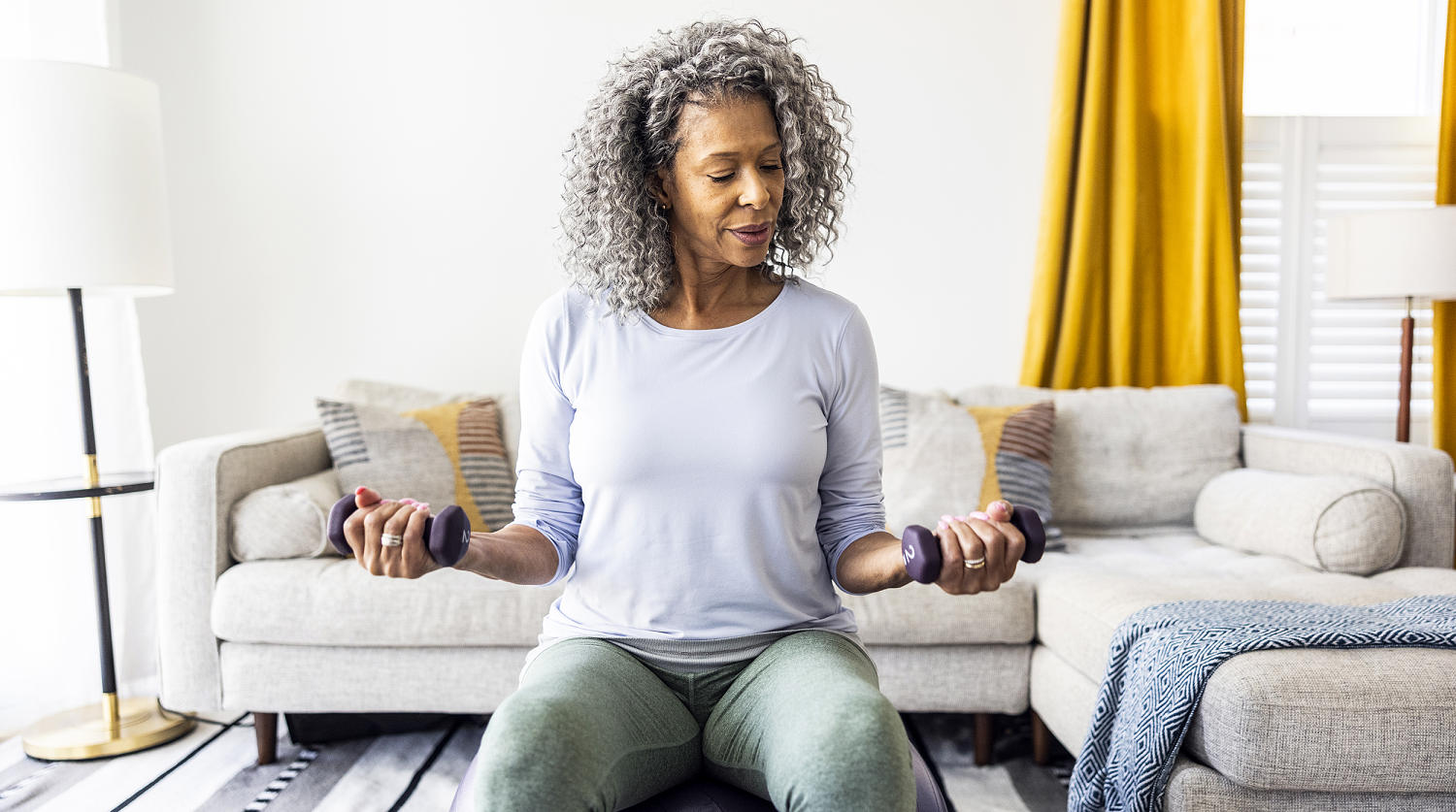When you hear the term "healthy aging," you may feel it's something that doesn't apply to you yet. But we need to be concerned about our longevity earlier than we think. After age 30, men and women per decade and this loss accelerates after age 60.
This is especially true for women since menopause further exacerbates bone and muscle loss. Plus, women have traditionally been less likely to engage in strength training, often choosing out of fear of bulking up. Not only does a regular strength-training routine help to combat the natural loss of muscle mass, but it strengthens our bones (which also weaken with age) and can even add years to our life, according to a The study found that women who strength trained two to three times a week were more likely to live longer and were 30% less likely to die from heart disease.

That's why, in honor of Women's Health Month, we tapped our Start TODAY experts to create a fitness challenge that is designed to help make strength training a consistent part of your routine, while also introducing some other important modalities that can help everyone stay strong and healthy as they age. "What I love is seeing more women and people over 50 increasingly recognizing the importance of strength training," says Natalie Yco, Start TODAY fitness trainer and creator of the "Best Butt Ever" program for Equinox. "My middle-aged clients often notice significant changes in their body composition and strength, but what stands out to me is the and self-esteem.
Additionally, this newfound awareness often leads them to adopt healthier habits overall." This 31-day program will help you prioritize both your physical and mental health. It is designed to help you build muscle mass, address aches and pains, , and release tension.
While Yco's passion is helping women and strength, she also stresses the importance of a well-rounded routine. This is why the monthly plan also includes , yoga and recovery days with mobility and stretching. For those days, here are some routines to get you started: For full guided routines with our experts served to you daily, ! "As we age, muscle mass declines due to a process called sarcopenia.
Strength training helps counteract this loss, preserving muscle and functional ability," says Yco. "But the benefits don’t stop there. Strength training also helps improve bone density, metabolic health, , mental well-being and cognitive function.
It’s a holistic approach to and enhancing the quality of life." While these benefits of strength training can be reaped by anyone, it's especially important for women who are pre- and post-menopausal. "Menopause leads to a decline in estrogen, which can affect muscle mass and bone density," says Yco.
"Strength training helps counteract these changes by stimulating muscle growth and enhancing bone health. It’s also helpful for cognitive function, improves insulin resistance, and to help improve body composition." While strength training is an important component of an exercise routine for women, a well-rounded routine is just as important.
And Yco has learned this firsthand as she herself has gotten older. "As I’ve aged, I’ve made adjustments that may not be what people often expect. My focus is on lifting heavy weights 3-4 times a week, combined with (HIIT) or sprint intervals twice a week, she says.
"However, menopause has prompted me to adapt my strength-training routine to incorporate more recovery, mobility work, and flexibility exercises to prevent injuries. I typically push hard for 2-3 weeks and then take a deload week or two, always listening to my body. Plus, I , which I absolutely love! Not only does it increase my (NEAT), but it also helps boost my mood!" Yco shares her best tips for easing into a strength-training routine so that you stick with it, avoid injury and see results: Remember that progress takes time and consistency — nothing happens overnight.
This full-body routine from Yco uses her heavy weight, low rep approach to strength training. The routine is designed using supersets, a training style "where you perform two exercises back to back, which allows you to get more work done in a shorter amount of time," says Yco. You will perform 3 rounds total two focused on upper and lower body compound movements, plus a bonus arm round aiming for 4-6 reps per exercise.
"Focus on slow and controlled movements. The goal is to lift heavier, but not max out, you want to remain about 2 reps shy of failure," say Yco. "This approach will help you build strength safely and effectively.
" Start with feet hips-width apart, toes turned out on a slight angle. Sit your butt down and back, as if you are sitting into a chair, to sink down into a squat. Make sure to keep the knees tracking over the toes.
Push through the heels to come back up to standing. Repeat. Start with feet hips-width apart, toes turned out on a slight angle.
Sit your butt down and back, as if you are sitting into a chair to sink down into a squat. Keep the knees tracking over the toes. At the bottom of the squat, grab your toes with your hands.
Keep hold of your toes as you lift the butt back up toward the sky, straightening the legs. Let your head fall toward the ground. Feel the stretch in the hamstrings.
Come back down into a squat position and repeat. Start standing with your feet hips-width apart. Place your hands behind your head, with your elbows reaching out to the sides.
Keep a slight bend in the knee and hinge at the hips, sending the glutes back behind you and your chest toward the floor. Be sure to keep the core engaged so there is no arch in your back. Stop when your chest is parallel to the floor and you feel a .
Use your hamstrings and glutes to pull yourself back up to standing. Repeat. Start on all fours on the ground.
Sit your hips back to rest on your heels. Straighten your arms out in front of you and let your forehead rest on the mat in . From here, move into up dog by scooping the chest forward and lifting the head toward the sky, straightening the legs and pressing down into both palms.
Let the upper thighs rest gently on the mat, but keep your pelvis and torso elevated. Move back through child's pose and repeat. Start lying on your back with your knees bent and feet flat on the floor.
Rest your arms down by your sides. Engage the glutes and push through the heels to lift your butt off the ground and raise your pelvis toward the sky. Your body should form a straight line from your knees to your neck.
Hold at the top, squeezing the glutes, before slowly lowering back down. Repeat. Stand with feet hips-width apart.
Place a dumbbell behind each heel. Hold a dumbbell in each hand at shoulder height. Carefully step your heels up onto the dumbbells, keeping your toes on the ground.
Sink down into a squat, lowering to at least a 90-degree angle at the knees, but lower if your range of motion allows. Squeeze the glutes and push through the heels to come back up to standing. Repeat.
Hold a dumbbell in your right hand. Come into a staggered stance with your left leg in front and your right leg back behind you. Hinge forward at the hips, keeping your back straight and a slight bend in both knees.
Lightly rest your left hand on your left knee. Let the right arm holding the dumbbell hang straight down toward the ground. This is your starting position.
From here, pull your elbow straight up toward the ceiling, bringing the dumbbell to your ribcage. Lower it back down to the starting position. Repeat for 4-6 reps and then switch sides.
Start standing with your feet hips-width apart, holding a dumbbell in each hand in front of the thighs. Hinge at the hips, pushing the glutes toward the back of the room and letting the chest fall toward the ground, sliding the dumbbells down your legs. Stop when you feel a stretch in the back of the legs or if your mobility allows, when your chest is parallel to the ground and the dumbbells reach your shins.
Engage the glutes and hamstrings to pull yourself back up to standing. Repeat. Sit on the floor and place a dumbbell on either side of your body.
Then, lie down on your back with your knees bent and feet flat on the floor. Grab a dumbbell in each hand and bring your arms into a goal-post position with the biceps parallel to the ground and the weights pointing toward the sky. This is your starting position.
Keeping the core engaged, push both dumbbells straight up over your chest. Slowly bring them back down to the starting position and repeat. Start standing with your feet hips-width apart, holding a dumbbell in each hand.
Hold each dumbbell by one end and push them straight up overhead, bringing them together so they gently touch. Keeping your biceps still, bend at the elbows to lower the dumbbells down behind your head. Engage the triceps to pull them back up toward the sky.
Repeat. Start standing with your feet hips-width apart, holding a dumbbell in each hand. Keeping your biceps glued to your ribcage, bend at the elbows, pulling the dumbbells up toward your shoulders.
Squeeze at the top before slowly lowering the dumbbells back down to your sides. Repeat. Brianna Steinhilber is a health editor for TODAY.
com. She is a NASM-certified personal trainer with a journalism degree from Fordham University..
Health

Women who do this 1 type of exercise live longer. Get started with a 31-day plan

This strength training workout plan for women post-menopause improves functional fitness, builds strength, muscle mass, and bone density and boosts metabolism.















